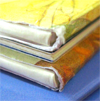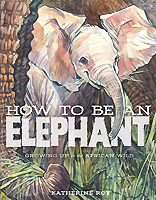|
|
|
|
|
|
|

| 최근 이 책을 구매하신 다른 회원의 책장 |
|
 |
|
|
|
[ 책 소개 ]
* A School Library Journal Best Book of the Year
* A Horn Book Fanfare Best Book of the Year
* A Chicago Public Library Best Book of the Year
* Evanston IL Public Library Best Books of the Year
* School Library Journal, Best Books of the Year
* Chicago Public Library Best of the Best
* Horn Book Magazine Fanfare List
* Booklist Editors' Choice
* NSTA-CBC Outstanding Science Trade Book
여러 기관들과 매체로부터 "올해의 책"으로 선정된 훌륭한 논픽션 그림책.
아프리카 대평원 지역에서 태어나고 자라는 코끼리의 성장과정과 함께, 군락을 이루며 가족단위로 모여 사는 코끼리의 습성과 특성을 매우 사실적인 수채화 그림과 함께 흥미진진하게 소개합니다.
코끼리는 지구상의 동물 중에서 매우 드물게도 가족 단위로 평생을 함께 삽니다. 이 무리의 우두머리는 나이 많은 암컷이지요. 코끼리는 태어나는 순간부터 평생 동안 가족들로부터 생존을 위한 다양한 것들을 배우며, 대대손손 후손들에게 전수가 됩니다....
이 책에서는 이외에도 아래와 같은 내용들을 포함하고 있습니다.
- 코끼리의 신체 내부구조,
- 남다른 후각기능,
- 코끼리 코가 하는 다양한 일들,
- 코끼리들의 소리를 통한 의사소통능력,
- 코끼리의 소화기능,
- 코끼리의 체온 조절 및 보온 능력,
- 맹수를 대처하는 방법,
- 장거리 신호를 보내는 방법,
- 코끼리와 다른 동물들의 조화로운 생태계...
튼튼한 | 닫기x |  What is 하드커버? What is 하드커버?
양장본이라고도 불리우며, 표지가 단단한 판지로 만들어진 책입니다.
판지를 천이나 가죽으로 감싸기도 합니다. 책의 속지는 일반적으로 중성처리된 종이(Acid-free paper)를 사용해서 잘 변질이 되지 않기 때문에 오랫동안 보관하기에 적합합니다. 이 종류의 책은 더스트 재킷, 또는 더스트 커버로 불리는 표지덮개가 함께 있는 경우가 많습니다. 간혹 내부 속지가 콩기름 코팅이 된 경우 고약한 냄새가 나는 책도 있습니다.
|
[ 관련 동영상 보기 ]
 ▶
[ 서지 정보 ]
Hardcover: 48 pages
ISBN-10: 1626721785
ISBN-13: 978-1626721784
책 크기: 28.5 cm x 22.3 cm
[ 영문 서평 ]
Book Description
The savanna is not an easy place to live, even for African elephants, the largest land animals on earth. If it's a challenge for these 7,000-pound giants, what's it like for their newborn babies?
An infant elephant has precious little time to learn the incredible array of skills that are necessary to keep up, from projecting her voice across a 10-octave range to using the 100,000 muscles in her trunk to stay hydrated. But this giant-to-be has the perfect classroom--a family herd made up of her mother, sisters, cousins, and aunts. With their help and protection, she'll learn how to survive, how to thrive, and how to be an elephant.
Award-winning author-illustrator Katherine Roy's How to Be an Elephant delves into the intricate family dynamics at play in a typical African herd. Drawing upon the latest scientific research and Roy's own expedition to Kenya, and brimming with lush watercolor illustrations and detailed diagrams, this book vividly portrays the life and development of an elephant from an uncertain newborn into a majestic adult. As informative as it is beautiful, Roy's unique portrait of an elephant's life will captivate young explorers and animal lovers alike.
New York Times Book Review
"The energetic illustrations are whimsical on one page, scientifically precise on the next . . . Roy reels you in with startling facts, then shows how a dominant species is really vulnerable, dependent on humans to choose to practice conservation."
Booklist *Starred Review*
"Exceptional and arresting... Roy holds readers' attention with her approachable writing style and astonishing statistics."
Publishers Weekly *Starred Review*
“Immersive illustrations and careful attention to detail in both the text and art combine to create a rewarding study of a remarkable animal.”
School Library Journal *Starred Review*
"A must-have."
The Horn Book *Starred Review*
A baby African elephant is born and immediately begins developing the important skills necessary to survive in the wild. In detailed accounts that integrate descriptions of elephant anatomy, behavior, and development, Roy carefully explains how the baby learns to walk, communicate, listen, and use her trunk. Diagrams and sketches illustrate interior and exterior organs, including the remarkably versatile trunk (a multipurpose tool — likened to a Swiss Army Knife — that “helps a baby elephant eat, breathe, smell, scratch, sound, gesture, dig, and drink”). All this learning takes place in the family herd, where female elephants collaborate to raise their young and pass down generations of knowledge. Roy’s dynamic illustrations of the elephants are masterful: bold strokes that provide definition to the wrinkled skin of the elephants also skillfully convey movement, and the perspective is mostly from the level of the young calf, low to the ground and close to the towering legs of protective adults. The back matter includes an author’s note detailing Roy’s visit to Kenya to learn about elephants and threats to their existence (with appended map) as well as selected sources, both print and film.
|
|
|
|
|
|
|
|
|